- Home
- »
- Next Generation Technologies
- »
-
Farming As A Service Market Size And Share Report, 2030GVR Report cover
![Farming As A Service Market Size, Share & Trends Report]()
Farming As A Service Market Size, Share & Trends Analysis Report By Service (Farm Management Solutions, Production Assistance, Access to Markets), By Delivery Model (Subscription, Pay-per-Use), By End-user, By Region, And Segment Forecasts, 2024 - 2030
- Report ID: GVR-4-68039-964-9
- Number of Report Pages: 125
- Format: PDF, Horizon Databook
- Historical Range: 2017 - 2023
- Forecast Period: 2024 - 2030
- Industry: Technology
Farming As A Service Market Size & Trends
The global farming as a service market size was valued at USD 4.09 billion in 2023 and is expected to grow at a compound annual growth rate (CAGR) of 15.0% from 2024 to 2030. Farming as a Service, generally abbreviated as FaaS, is a framework of professional services that offer a suite of agrarian management solutions. It gives farmers access to various services such as precision farming tools, analytics, utility & labor services, equipment rentals, and entrance to broader audiences & markets, among others. Factors such as increasing adoption of modern agricultural methods, reducing labor costs, and rising demand for food due to the growing population are significant drivers attributing to industry's growth
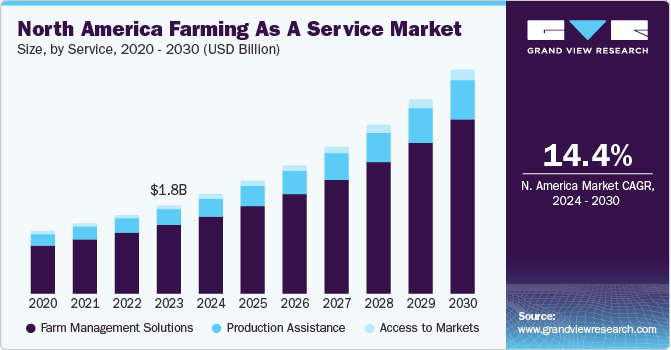
The FaaS market is segmented as service type, delivery model, and end-user. The service segment is further segmented into three sub-segments: farm management solutions, production assistance, and market access. Analytics services are concerned with metrics like yield monitoring, weather data, germination data, soil quality data, etc., which are dealt with in farm management. Access to markets deals with cutting out intermediaries and linking farmers directly to suppliers and marketplaces using technologies like IoT and mobile end-users.
Production support deals with outsourcing or leasing of both equipment and human resources. The delivery model is further bifurcated into two service types: subscription and pay-per-use. In a subscription model, the farmer rents out equipment for a certain period. In pay-per-use service type, the farmer pays for equipment each time he uses it. FaaS prevents resource misuse and encourages increased crop productivity. Due to the increased use of farming-as-a-service, farmers are becoming more proficient in smart livestock monitoring, farm management, information sharing, and precision farming, among others.
In July 2020, DeHaat, an end-to-end farming solutions & service provider, adopted a franchise-based approach. DeHaat Center in Jaipur is a franchise that provides services such as farm inputs to produce offloading. Farmers can obtain advisory services at the center, over the phone, and through the DeHaat mobile app. Jaipur’s DeHaat center serves 300-400 farmers. More than 650,000 farmers in Bihar, Jharkhand, Odisha, West Bengal, and Uttar Pradesh are supported by approximately 1,890 franchises.
According to a study published by the International Labor Organization (ILO), "Improving market access for smallholder farmers," farmers who used FaaS techniques on their farms noticed significant improvement in both the quality and quantity of their produce. According to the findings of the report, farmers who sold their products through 'Out Grower' scheme saw an increase in their income by USD 274 per farm in a year as opposed to farmers who stuck to traditional methods, which saw a rise of only USD 31 per farm in a year.
Farmers enrolled in the scheme were also able to meet order demand consistently. The model was mapped into a simple value chain that included farmers, retailers, distributors, and consumers. Farmers who participated in the intervention improved their horticulture production methods over those who did not. When participating in 'Out Grower' program, producers should practice effective farm management, which includes rain, seedling nurseries, and garden beds protective tunnels) the average increase in productivity went up by 17%, from 44% in a year to 61% in a year after enrolling in a program.
The company's assistance to farmers was crucial because they faced a lack of quality transportation, guidance, supply chain issues, etc. A drastic change in the selling patterns of farmers was also noticed as they switched from selling to the neighborhood market to selling via Josephina Farm. Before the intervention, farmers typically sold 69% of their output at regional markets. This decreased to 17% after the intervention, with the remaining 65% being sold to corporations. Farmers reported a slight decline in food production for family use (from 16% of yield before intervention to 11% after intervention).
The outbreak of). the COVID-19 pandemic had adverse effects across several industries. Lockdowns imposed and restrictions on the movement of goods and people had an impact on the functioning of the agriculture sector as well. However, agricultural goods being an essential commodity, the movement of agricultural inputs and agricultural produce was permitted.
After a small setback to the functioning of agriculture logistics in the initial few months of lockdown, agriculture logistics limped back to normalcy by the end of the year 2020. Farm management solutions such as precision farming tools and analytics gained more relevance in the wake of a pandemic as they allowed remote monitoring of several parameters, such as yield monitoring, pest prevention, and irrigation.
Market access services that connect farmers to end-users through the use of mobile end-users were highly utilized. The effect of the COVID-19 pandemic was comparatively low on the agriculture sector. Demand for services under farming as a service model continued to grow owing to stable demand for agricultural products.
Several players in the FaaS industry were able to raise funds in the recent past, which helped them maintain cash flow. Clover Ventures Private Limited and LeanCrop Delivery Model Access to Markets Pvt. Ltd. are some of the companies that raised funds recently.
Market Concentration & Characteristics
The market growth stage in farming as a service market is high, and the pace of the market growth is accelerating. The farming as a service market is characterized by a high degree of innovative offerings owing to the approach toward overcoming the lack of technical know-how and shortage of skilled labor and improving the dissemination of information to increase technical knowledge.
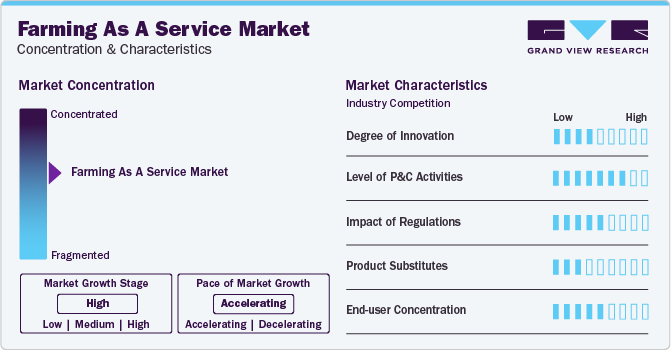
Farming as a service market is also characterized by a high level of merger and acquisition (M&A) activity by the leading players. This is due to several factors, including the desire to gain high market share and the need to consolidate in a rapidly growing market.
Farming as a service market faces heightened regulatory scrutiny, primarily focused on data privacy and transparency in business agreements. Given the nature of farming as a service, which involves extensive data collection and analysis related to crop yields, weather conditions, and soil health, compliance with stringent data privacy and security regulations is imperative. Safeguarding farmers' and stakeholders' information is crucial for maintaining trust and adhering to legal requirements. Furthermore, ensuring transparency in subscription terms, service-level agreements, and any associated legal considerations becomes a critical aspect of compliance for farming as a service providers. This emphasis on regulatory adherence is essential for sustainable growth and to meet the evolving standards in the agricultural technology landscape.
Farming as a service currently lacks a direct substitute, given its unique model of providing comprehensive agricultural solutions. However, challenges may arise from the traditional mindset of end-users who prefer owning equipment rather than opting for service-based solutions. Additionally, the market may face competition from advanced products offering precise outcomes, requiring farming-as-a-service providers to continually innovate and demonstrate the superior value proposition of their offerings.
End-user concentration plays a pivotal role in the farming-as-a-service market, with a growing number of end-users, particularly in developing countries, embracing this model. The surge in farming activities has led to increased demand for innovative services among farmers. The adoption of farm management solutions is a notable trend, empowering farmers to make informed decisions based on data analytics rather than relying on arbitrary judgments. This shift toward data-driven decision-making highlights the transformative impact of farming-as-a-service solutions on agricultural practices, enabling greater efficiency and precision in the management of farming operations.
Market Dynamics
The global agriculture industry employs over a billion people and produces food and food products worth approximately USD 1.3 trillion annually. To meet the rising demand for high-quality sustainable products, farmers are adopting environmentally responsible practices that promote soil health and biodiversity and minimize the use of harmful chemicals. Sustainable agriculture practices such as organic farming, agroforestry, precision farming, integrated farming systems, vermicomposting, crop rotation, and intercropping also provide benefits such as higher crop yields and increased profits for farmers.
Technological advancements are driving the growth of the Farming as a Service (FaaS) market. An increasing number of companies in the FaaS market are introducing advanced products in response to the rising demand for sustainable agriculture practices. One of the primary drivers of this market is the use of digital platforms that allow farmers to collect and analyze data on soil health, crop yields, and weather conditions, among other factors.
Agritech startups are important drivers of innovation in the agriculture industry, creating lucrative opportunities for the market in the long run. They are introducing new technological advancements that enable farmers to overcome challenges related to efficiency, sustainability, and profitability. These startups are also making these technologies more accessible and affordable, which benefits small farmers in developing countries.
Service Insights
Based on service type, farming as a service market is segmented into farm management solutions, production assistance, and access to markets. The farm management solutions segment held the largest market share of about 76.83% in 2023. Farm management solutions include solutions such as providing insights to government, farmers, corporates, and other final advisory firms.
Farm management services also include precision farming services, which have shown tremendous growth in recent years owing to the growing acceptance of precision farming to meet the rising global demand for high-quality food products. Tools such as hyperspectral imaging technology, sensors (to gather data on weather conditions and soil health), auto-guidance equipment, precision irrigation systems, etc., to improve agricultural results.
Further boosting demand for precision farming and quickening market expansion is the worsening water issue and the growing need to conserve natural resources. Production assistance is further sub-segmented into equipment rentals, labor, utility services, and agricultural marketing. Equipment rental services include renting farming equipment such as tractors, combines, etc.
These rental services are used by small and medium-scale farmers. Labor services include renting or outsourcing labor and other workforce requirements for a field. Renting out labor helps the farmer with one less task of labor management and can focus on other work. The utility services segment provides services such as irrigation and power grid services.
The access to market segment is expected to grow at the fastest CAGR of 15.6% during the forecast period. Access to lucrative, value-added marketplaces is sometimes limited for smallholder farmers. Farmers struggle to transition from one crop to another without essential supporting services, such as infrastructure and service provision barter and subsistence trade for more beneficial service types of exchange.
The access to markets segment of FaaS addresses this exact problem and connects the farmers and the suppliers and further the suppliers and the final consumer through digital means such as mobile end-users, websites, helpline numbers, etc.
Delivery Model Insights
Based on the delivery model, the market is segmented into subscription and pay-per-use. The subscription delivery model held the largest revenue share of more than 58.50% in 2023 and is expected to command a majority of revenue share during the forecast period. Subscription services deal with farmers renting or leasing out farming equipment for a particular period, such as 3 to 4 months.
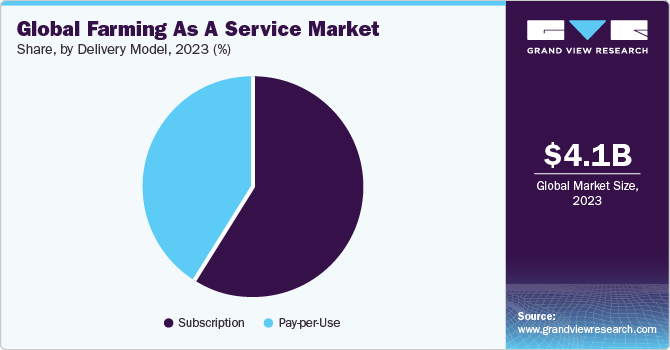
Subscription services help farmers who need some specific equipment only once or twice a year for a certain period. Pay-per-use is a service where a farmer pays for equipment every time he uses it, and there is no particular time frame for which he rents out equipment. Subscription services are economically more beneficial in the long run because farmers spend more on the pay-per-use model over a longer period.
For instance, a small-scale wheat-producing farmer who can't afford a combine harvester can rent it for a particular period when he wants to mow their wheat produce. Pay-per-use and subscription models are available, but the subscription model will be more viable as farmers will pay more in the long run.
Pay The use model can be used where the period of renting equipment is small, such as 1 or 2 days. For instance, Trringo, a Mahindra and Mahindra-based venture, is a startup that focuses on equipment rental and related services. Trringo operates on a franchise and marketplace-based model. Mahindra and Mahindra recently provided seed funding to a company named Gold Farm. Gold Farm is a farm equipment aggregator.
End-Use Insights
Based on end-users, the market is segmented into farmers, government, corporate, financial institutions, and advisory bodies. Farmers were the largest end-users of farming as a service, as the segment held a revenue share of more than 30.41% in 2023. Also, the farmer end-user segment is anticipated to be the fastest-growing segment, with a CAGR of 15.4% during the forecast period. Farmers are primary users of Farming as a service.
Farmers use all service types, such as farm management solutions, production assistance, and access to markets. Farmers use farm management solutions to allow them to make informed decisions based on data rather than random guesses. Farmers also use production assistance services such as equipment rentals, labor services, utility services, and agricultural marketing.
The government sector only uses access to market features so that they can use FaaS providers to eliminate middlemen from the farming industry, which will benefit farmers in the long run. Farm management solutions are utilized by banks and financial institutions for various purposes, such as risk management, speeding up loan claims, etc. Risk assessment is an essential metric for financial institutions to ensure the viability of the investment.
Regional Insights
North America dominated the market and accounted for a share of 45.41% in 2023.North America is one of the largest farming economies in the world and has one of the largest average farm sizes around the globe. North America currently has around 897,400,000 acres under cultivation, and the U.S. has an average farm size of approximately 445 acres.
The sizeable average farm size and large area under cultivation make North America the prominent region in the farming as a service market. The significant market share of the region has been ascribed to the increased use of automation and control systems in the majority of the countries, as well as the increasing acceptance of smart farming methods, which has led to an increase in the use of agriculture farming-as-a-service.
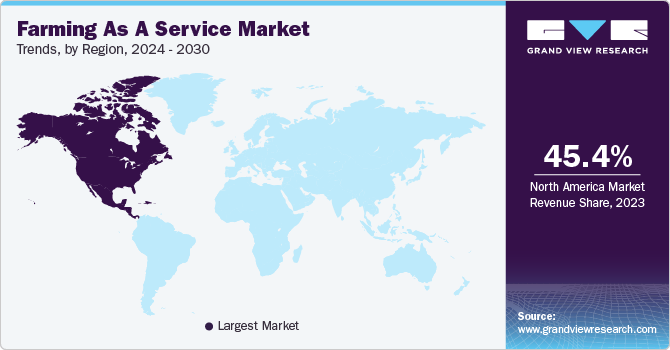
The Asia Pacific region is expected to grow at the highest CAGR during the forecast period. The growth is due to agro-based economies such as India, China, and Bangladesh, which have agriculture as the highest contributor to these countries' respective GDPs. The growth is primarily a result of the region's expanding population and rising food demand. Other significant factors anticipated to fuel regional expansion in the coming years include strong support from governments of various nations in the Asia-Pacific region for supporting the adoption of FaaS models in the agriculture sector and fast-improving infrastructural facilities. It is projected that the food consumption patterns will change due to the population's exponential growth, posing difficulties for agricultural production.
The governments of various regions encourage the adoption of Farming-as-a-Service models and farmers' use of cutting-edge technology to close the food gap, which will drive the regional industry during the forecast period. For instance, Mahindra has erected more than 1,000 technique plots across India to highlight the advantages of utilizing Krish-e, which is Mahindra and Mahindra farming as a Service branch. Mahindra has so far observed an increase in income per acre of USD 63 to USD 186 for farmers who have embraced Krish-e-assisted farming techniques.
The European farming industry is dominated by countries like France, the largest agro-based economy in Europe. France produces roughly 23% of the entire E-15 nation's agricultural produce, and Germany and Italy follow France in the volume of European farm produce. The major agricultural products in Europe are cotton, off-season fruits and vegetables, cocoa, tea, spices, soybean products, and coffee. FaaS technologies are widely used in Europe to monitor the products' quantity and quality.
U.K. Farming as a Service Market
The farming as a service market in the U.K. is expected to account for a significant revenue share in the global market. The UK has seen significant advancements in agricultural technology, including precision farming, IoT devices, drones, and data analytics. These technologies enable farmers to optimize crop production, improve resource efficiency, and make data-driven decisions.
Germany Farming as a Service Market
The farming as a service market in Germany is expected to account for a significant revenue share in the global market. farming as a service offers farmers an opportunity to access specialized expertise, advanced technologies, and economies of scale, helping them improve operational efficiency and profitability.
France Farming as a Service Market
The farming as a service market in France is expected to account for a significant revenue share in the global market. There is a growing emphasis on sustainable agriculture in France, driven by environmental concerns, consumer demand for ethically produced food, and government policies promoting sustainable farming practices.
China Farming as a Service Market
The farming as a service market in China is expected to account for a significant revenue share in the global market. China is experiencing rapid advancements in agricultural technology, driven by government initiatives, research institutions, and private sector investments.
India Farming as a Service Market
The farming as a service market in India is expected to account for a significant revenue share in the global market. India agricultural land is fragmented into small plots owned by individual farmers, making it challenging to achieve economies of scale and adopt modern farming practices. Farming as a service models enable farmers to access shared machinery, equipment, and expertise, reducing costs and improving resource utilization.
Japan Farming as a Service Market
The farming as a service market in Japan is expected to account for a significant revenue share in the global market. Environmental concerns, soil degradation, water scarcity, and food safety issues are driving the adoption of sustainable farming practices in Japan.
South Korea Farming as a Service Market
The farming as a service market in South Korea is expected to account for a significant revenue share in the global market. The South Korea government has launched various initiatives to promote agricultural modernization, innovation, and rural development. Policies supporting technology adoption, infrastructure investment, and financial incentives for farmers encourage the growth of FaaS models and agri-tech startups.
Brazil Farming as a Service Market
The farming as a service market in Brazil is expected to account for a significant revenue share in the global market. Urbanization trends in Brazil are leading to labor shortages in rural areas, prompting the need for labor-saving technologies and mechanization in agriculture. FaaS solutions automate repetitive tasks, reduce dependency on manual labor, and enable remote monitoring and management of farm operations.
Saudia Arabia (KSA) Farming as a Service Market
The farming as a service market in Saudi Arabia (KSA) is expected to account for a significant revenue share in the global market. Saudi Arabia (KSA) agricultural sector is undergoing structural reforms, including market liberalization, consolidation of land holdings, and the emergence of large-scale commercial farms. FaaS providers offer services tailored to the needs of large-scale producers, agribusinesses, and supply chain stakeholders, driving industry consolidation and vertical integration.
Key Farming As A Service Market Company Insights
Because of the growing world population, there is severe food scarcity everywhere. This is one of the main driving forces behind the demand for farming as a service. It offers analytical outputs and predictive analytics to support effective crop development and animal health. In addition to the other factors mentioned, a severe lack of skilled laborers and fertile land impacts the demand for valuable and data-driven insights to maximize crop yields.
Additionally, governments in many nations are enforcing strict restrictions on the use of crop protection chemicals in response to growing environmental concerns, which is favorably affecting farm management software sales globally by boosting productivity and return on investment (ROI). Leading market firms also consistently support R&D initiatives to build efficient FaaS solutions. This is expected to drive the industry, along with emerging technological developments like the blend of the Internet of Things (IoT) and cloud computing.
Some of the key players operating in the market include Mahindra and Mahindra, John Deere, ITC, Trimble, EM3, Apollo Agriculture, Accenture, Taranis, Precision Hawk, IBM among others.
-
Mahindra & Mahindra Ltd. manufactures farm equipment and automotive vehicles. The company also offers information technology, hospitality, and financial services. The company’s subsidiaries include Mahindra Engineering and Chemical Products Limited, Mahindra Overseas Investment Company (Mauritius) Ltd., Mahindra Vehicle Manufacturers Limited, Mahindra Two Wheelers Europe Holdings S.a.r.l., Mahindra USA, Inc., Mahindra Consulting Engineers Limited, Mahindra Holdings Limited, and Mahindra Airways Limited.
-
Deere & Company is engaged in the manufacturing & construction of agricultural and forestry machinery; drivetrains and diesel engines for heavy equipmeand nt; and lawn care machinery. Additionally, the company also manufactures and provides other heavy manufacturing equipment. The company serves diverse industries such as agriculture, forestry, construction, landscaping & grounds care, engines & drivetrain, government and military, and sports turf.
-
Agrostar and Bighaat are some of the emerging market participants in the target market.
-
Agrostar is an agriculture product and service provider. The company, through its platform, provides farmers with expert advice, agricultural information, agronomy information, and weather forecasts.
-
Bighaat is an agritech startup that provides farmers with a platform where they can exchange information and learn about all aspects of farming. The company also offers products and services, including healthcare and crop support services.
Key Farming As A Service Companies:
The following are the leading companies in the farming as a service market. These companies collectively hold the largest market share and dictate industry trends. Financials, strategy maps & products of these farming as a service companies are analyzed to map the supply network.
- Mahindra and Mahindra
- John Deere
- ITC
- Trimble
- EM3
- Apollo Agriculture
- Accenture
- Taranis
- Precision Hawk
- IBM
- BigHaat
- Ninja Kart
Recent Developments
-
In January 2023, Taranis announced the official launch of AcreForward, a new solution designed to assist ag retailers in driving more value from each acre of land. The solution was designed to provide unparalleled leaf-level data regarding growers’ crops at a higher frequency throughout the season and cash in on the potential in each acre, including new insights into carbon sequestration and soil health.
-
In July 2022, ITC Limited announced the launch of ITCMAARS (Meta Market for Advanced Agricultural Rural Access to Markets), a full-stack agritech app aimed at strengthening the company’s agri-business vertical. The company was looking forward to assisting farmers with Farming As A Service-based and ML-based personalized crop advisories.
Farming As A Service Market Report Scope
Report Attribute
Details
Market size value in 2023
USD 4.09 billion
Revenue forecast in 2030
USD 10.73 billion
Growth Rate
CAGR of 15.0% from 2024 to 2030
Actual data
2017 - 2023
Forecast period
2024 - 2030
Quantitative units
Revenue in USD billion and CAGR from 2024 to 2030
Report coverage
Revenue forecast, company ranking, competitive landscape, growth factors, and trends
Segments covered
Service, Delivery Model, End-user, and Region
Regional scope
North America, Europe, Asia Pacific, South America, MEA
Country scope
U.S.; Canada; Mexico; U.K.; Germany; France; Italy; Japan; China; India; Australia; Southeast Asia; Brazil
Key companies profiled
Mahindra & Mahindra; John Deere; ITC; Trimble; EM3; Apollo; Accenture; Taranis; BigHaat; Precision Hawk; IBM; NinjaKart
Customization scope
Free report customization (equivalent up to 8 analysts working days) with purchase. Addition or alteration to country, regional & segment scope.
Pricing and purchase options
Avail customized purchase options to meet your exact research needs. Explore purchase options
Global Farming As A Service Market Report Segmentation
This report forecasts revenue growth at global, regional, and country levels and provides an analysis of the latest industry trends in each of the sub-segments from 2017 to 2030. For this study, Grand View Research has segmented global farming as a service market report based on service, delivery mode, end-use, and region.
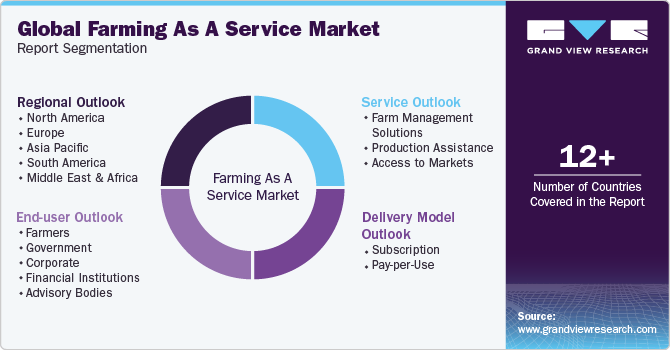
-
Service Outlook (Revenue, USD Billion, 2017 - 2030)
-
Farm Management Solutions
-
Precision Farming Tools
-
Analytics
-
Information Sharing
-
-
Production Assistance
-
Equipment Rentals
-
Labor services
-
Utility services
-
Agricultural marketing
-
-
Access to Markets
-
Supplier to farmers
-
Farmers to end market
-
-
-
Delivery Model Outlook (Revenue, USD Billion, 2017 - 2030)
-
Subscription
-
Pay-per-Use
-
-
End-user Outlook (Revenue, USD Billion, 2017 - 2030)
-
Farmers
-
Government
-
Corporate
-
Financial Institutions
-
Advisory Bodies
-
-
Regional Outlook (Revenue, USD Billion, 2017 - 2030)
-
North America
-
U.S.
-
Canada
-
Mexico
-
-
Europe
-
Germany
-
U.K.
-
France
-
Italy
-
-
Asia Pacific
-
China
-
Japan
-
India
-
Australia
-
Southeast Asia
-
-
South America
-
Brazil
-
-
Middle East and Africa (MEA)
-
Frequently Asked Questions About This Report
b. The global farming as a service market size was estimated at USD 3,623.2 million in 2022 and is expected to reach USD 4,090.3 million in 2023.
b. The global farming as a service market is expected to grow at a compound annual growth rate of 14.8% from 2023 to 2030 to reach USD 10.73 billion by 2030.
b. North America is one of the largest farming economies in the world and has one of the largest average farm sizes around the globe. North America currently has around 897,400,000 acres under cultivation.
b. Some key players operating in the farming as a service market include Mahindra & Mahindra, John Deere, ITC, Trimble, EM3, Apollo, Accenture, Taranis, BigHaat, Precision Hawk, IBM, and NinjaKart.
b. Key factors that are driving farming as a service market growth include increasing adoption of modern agricultural methods, reducing labor costs, and rising demand for food due to the growing population.
Share this report with your colleague or friend.
![gvr icn]()
NEED A CUSTOM REPORT?
We can customize every report - free of charge - including purchasing stand-alone sections or country-level reports, as well as offer affordable discounts for start-ups & universities. Contact us now
![Certified Icon]()
We are GDPR and CCPA compliant! Your transaction & personal information is safe and secure. For more details, please read our privacy policy.
We are committed towards customer satisfaction, and quality service.
"The quality of research they have done for us has been excellent."





